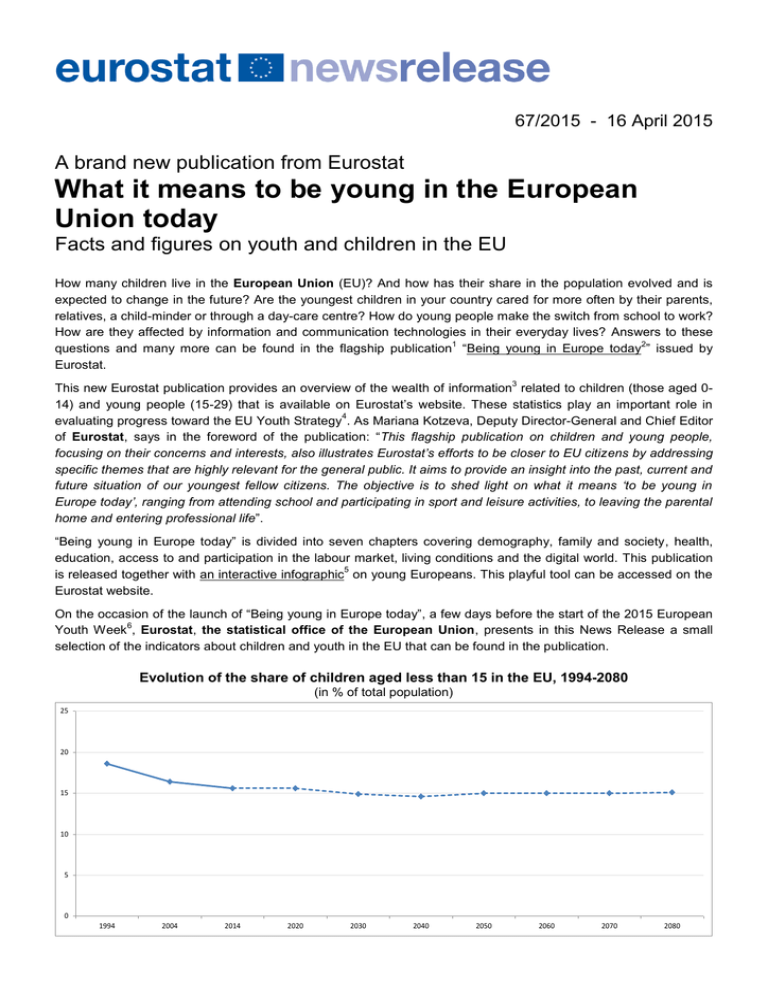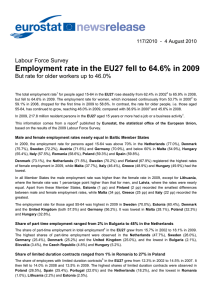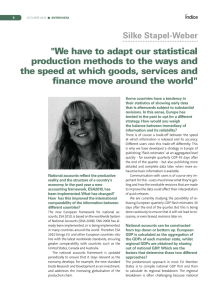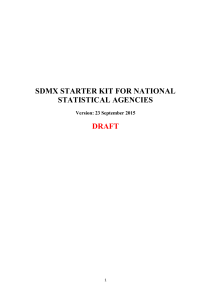What it means to be young in the European Union today
Anuncio

67/2015 - 16 April 2015 A brand new publication from Eurostat What it means to be young in the European Union today Facts and figures on youth and children in the EU How many children live in the European Union (EU)? And how has their share in the population evolved and is expected to change in the future? Are the youngest children in your country cared for more often by their parents, relatives, a child-minder or through a day-care centre? How do young people make the switch from school to work? How are they affected by information and communication technologies in their everyday lives? Answers to these 1 2 questions and many more can be found in the flagship publication “Being young in Europe today ” issued by Eurostat. 3 This new Eurostat publication provides an overview of the wealth of information related to children (those aged 014) and young people (15-29) that is available on Eurostat’s website. These statistics play an important role in 4 evaluating progress toward the EU Youth Strategy . As Mariana Kotzeva, Deputy Director-General and Chief Editor of Eurostat, says in the foreword of the publication: “This flagship publication on children and young people, focusing on their concerns and interests, also illustrates Eurostat’s efforts to be closer to EU citizens by addressing specific themes that are highly relevant for the general public. It aims to provide an insight into the past, current and future situation of our youngest fellow citizens. The objective is to shed light on what it means ‘to be young in Europe today’, ranging from attending school and participating in sport and leisure activities, to leaving the parental home and entering professional life”. “Being young in Europe today” is divided into seven chapters covering demography, family and society, health, education, access to and participation in the labour market, living conditions and the digital world. This publication 5 is released together with an interactive infographic on young Europeans. This playful tool can be accessed on the Eurostat website. On the occasion of the launch of “Being young in Europe today”, a few days before the start of the 2015 European 6 Youth Week , Eurostat, the statistical office of the European Union, presents in this News Release a small selection of the indicators about children and youth in the EU that can be found in the publication. Evolution of the share of children aged less than 15 in the EU, 1994-2080 (in % of total population) 25 20 15 10 5 0 1994 2004 2014 2020 2030 2040 2050 2060 2070 2080 Largest share of children in Ireland, lowest in Germany In 2014, the EU registered 10 million fewer children aged less than 15 than in 1994. The share of children in the total population decreased over the last twenty years in all Member States, except Denmark. The largest reductions in the proportion of children in the population were observed in Cyprus (from 25.2% in 1994 to 16.3% in 2014, or -8.9 percentage points), Poland (-8.7 pp), Slovakia (-8.2 pp) and Malta (-8.0 pp). In 2014, Ireland (22.0%) recorded by far the largest proportion of children, followed by France (18.6%), the United Kingdom (17.6%), Denmark (17.2%), Sweden (17.1%) and Belgium (17.0%). In contrast, in 2014 the lowest shares of young people where observed in Germany (13.1%), Bulgaria (13.7%) and Italy (13.9%). At EU level, children accounted for 15.6% of the total population in 2014, down from 18.6% in 1994. Share of children aged less than 15 in the EU Member States, 2014 (in % of total population) Ireland 22.0% France 18.6% United Kingdom 17.6% Denmark 17.2% Sweden 17.1% Belgium 17.0% Netherlands 16.9% Luxembourg 16.8% Finland 16.4% Cyprus 16.3% Estonia 15.8% EU 15.6% Romania 15.5% Slovakia 15.3% Spain 15.2% Poland 15.0% Czech Republic 15.0% Croatia 14.8% Latvia 14.7% Greece 14.7% Slovenia 14.6% Portugal 14.6% Lithuania 14.6% Malta 14.4% Hungary 14.4% Austria 14.3% Italy 13.9% Bulgaria 13.7% Germany 13.1% 0% 5% 10% 15% 20% 25% The share of children in the EU population is expected to slightly decrease in the future Based on population projections, the share of people aged less than 15 is expected to rise by 2050 in nine Member States compared with 2014, with the highest increases being projected for Lithuania (from 14.6% in 2014 to 16.6% in 2050, or +2.0 percentage points) and Latvia (+1.2 pp). On the other hand, Slovakia (from 15.3% in 2014 to 11.8% in 2050, or -3.5 pp), Portugal (-3.1 pp) Ireland (-2.6 pp), and Spain (-2.0 pp) could register the largest decreases in the share of children in their total population. At EU level, the share of children is expected to slightly decrease in the future, from 15.6% in 2014 to 15.0% by 2050. Children aged less than 15 in the EU Member States 1994 In thousand persons EU* 2014 Share in total population 2050 In thousand persons Share in total population In thousand persons Share in total population 88 628 18.6% 79 092 15.6% 78 643 15.0% Belgium 1 831 18.1% 1 906 17.0% 2 541 17.2% Bulgaria 1 573 18.6% 996 13.7% 813 14.1% Czech Republic 2 010 19.4% 1 577 15.0% 1 748 15.8% Denmark 889 17.1% 969 17.2% 1 057 16.5% Germany 13 308 16.4% 10 607 13.1% 9 456 12.7% Estonia 314 21.2% 208 15.8% 176 15.6% Ireland 903 25.2% 1 013 22.0% 962 19.4% Greece 1 888 18.0% 1 598 14.7% 1 175 12.9% Spain 6 874 17.5% 7 067 15.2% 6 027 13.2% France 11 819 20.0% 12 222 18.6% 12 963 17.4% Croatia : : 628 14.8% 531 13.9% Italy 8 495 14.9% 8 448 13.9% 9 153 13.6% Cyprus 160 25.2% 140 16.3% 153 14.8% Latvia 536 21.1% 294 14.7% 231 15.9% Lithuania 814 22.2% 430 14.6% 316 16.6% 73 18.1% 93 16.8% 183 17.4% 1 930 18.6% 1 426 14.4% 1 336 14.3% Luxembourg Hungary Malta 82 22.4% 61 14.4% 70 14.9% Netherlands 2 816 18.4% 2 850 16.9% 2 643 15.2% Austria 1 413 17.8% 1 219 14.3% 1 355 13.9% Poland 9 111 23.7% 5 719 15.0% 4 583 13.2% Portugal 1 836 18.4% 1 522 14.6% 1 023 11.5% Romania 4 878 21.4% 3 095 15.5% 2 728 15.2% Slovenia 379 19.1% 301 14.6% 307 14.8% Slovakia 1 256 23.5% 830 15.3% 577 11.8% Finland 971 19.1% 895 16.4% 1 009 16.4% Sweden 1 636 18.7% 1 646 17.1% 2 186 17.6% 11 268 19.5% 11 333 17.6% 13 341 17.3% 66 24.8% 67 20.5% 76 18.7% 6 19.3% 6 15.2% : : 836 19.3% 931 18.2% 1 340 17.4% 1 224 17.6% 1 212 14.9% 1 664 15.3% United Kingdom Iceland Liechtenstein Norway Switzerland * : EU refers to EU27 (without Croatia) for 1994 and to EU28 for 2014 and 2050. Data not available Young people leave the parental household earlier in the Nordic EU Member States In the EU, the average age of young people leaving the parental household stood at 26.1 in 2013. Significant differences can be observed across Member States. In 2013, the three Nordic Member States were, by far, the countries where young people left home earliest: at 19.6 years in Sweden, 21.0 years in Denmark and 21.9 years in Finland. They were followed by the Netherlands (23.5), France (23.6) and Germany (23.9). At the opposite end of the scale, young people in Croatia remained the longest in the parental household, with an average age of 31.9, ahead of Slovakia (30.7), Malta (30.1), and Italy (29.9). It should also be noted that in every EU Member State, young women tend to leave the parental household earlier than men, the highest differences between the genders being registered in Bulgaria (26.8 years for women, compared with 31.3 for men), Romania (26.2 vs. 30.7) and Croatia (30.2 vs. 33.7). Average age of young people leaving the parental household in the EU, 2013 EU Belgium Bulgaria Czech Republic Denmark Germany Estonia Ireland Greece Spain France Croatia Italy Cyprus Latvia Lithuania Luxembourg Hungary Malta Netherlands Austria Poland Portugal Romania Slovenia Slovakia Finland Sweden United Kingdom Total 26.1 24.9 29.1 26.7 21.0 23.9 24.3 25.6 29.3 28.9 23.6 31.9 29.9 27.8 24.5 25.9 26.4 27.8 30.1 23.5 25.4 28.2 29.0 28.5 28.8 30.7 21.9 19.6 24.1 Males 27.2 Females 25.0 25.8 31.3 27.8 21.4 24.8 25.1 26.5 30.7 29.8 24.5 33.7 31.0 28.9 25.2 27.0 27.0 29.0 31.0 24.3 26.6 29.3 30.0 30.7 30.1 32.1 22.8 19.9 25.0 24.1 26.8 25.6 20.5 22.9 23.5 24.8 27.9 27.9 22.8 30.2 28.7 26.7 23.7 24.8 25.9 26.6 29.2 22.6 24.2 27.0 28.0 26.2 27.5 29.3 21.1 19.3 23.1 More than 80% of young people in the EU participate in social networks In 2014, almost 9 out of 10 persons (87%) aged 16-29 used the internet on a daily basis in the EU, while this proportion fell to 65% for the total population. Moreover, almost three-quarters (74%) of young people in the EU used a mobile phone to access the internet, compared with less than half (44%) of the total population. Regarding on-line activities, young people in the EU were more likely to use the internet to make phone or video calls (46% of people aged 16-29, compared with 29% for the total population), to participate in social networks (82% compared with 46%) and to consult wikis for reference (65% compared with 44% in 2013). Youth and the internet in the EU: a way of life, 2014 (in % of population) 100% Total population 90% People aged 16-29 87% 82% 80% 74% 70% 65% 65% 60% 50% 46% 44% 46% 44% 40% 29% 30% 20% 10% 0% Use the internet daily * 2013 data instead of 2014. Participate in social networks Use a mobile phone to access the internet Consult wikis (to obtain knowledge on any subject)* Use the internet to make video or phone calls 1. 2. 3. 4. 5. 6. In late 2013, Eurostat introduced a new type of publication, the ‘flagship publication’, with the aim of providing statistical analyses relating to important social, economic or environmental phenomena. The aim of these publications is to address specific, highly relevant themes for the general public and European Union policy-making. Being young in Europe today is part of this new breed of publications. Eurostat publication “Being young in Europe today”. PDF-version available on the Eurostat website: http://ec.europa.eu/eurostat/product?code=KS-05-14-031. It can also be found in Statistics Explained: http://ec.europa.eu/eurostat/statistics-explained/index.php/Being_young_in_Europe_today Many indicators on youth in the EU are available on the dedicated section of the Eurostat website: http://ec.europa.eu/eurostat/web/employment-and-social-policy/youth For further information on the EU Youth Strategy, please see: http://ec.europa.eu/youth/policy/youth_strategy/index_en.htm A selection of interactive infographics primarily developed for young people but also for parents and teachers, is available on the Eurostat website: http://ec.europa.eu/eurostat/cache/infographs/youth/index_en.html. They cover four main areas: family, work, free time & studies and the internet. th Countries across Europe will be celebrating European Youth Week with hundreds of events and activities, from the 27 of th April to the 10 of May 2015: http://europa.eu/youth/eu/article/50/23771_en Issued by: Eurostat Press Office More information on the publication: Vincent BOURGEAIS Tel: +352-4301-33 444 [email protected] Fabienne MONTAIGNE Tel: +352-4301-35 582 [email protected] ec.europa.eu/eurostat @EU_Eurostat Media requests: Eurostat media support / Tel: +352-4301-33 408 / [email protected]



